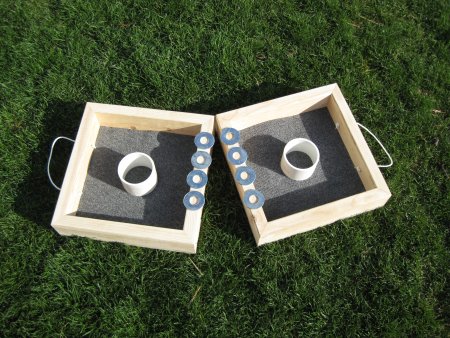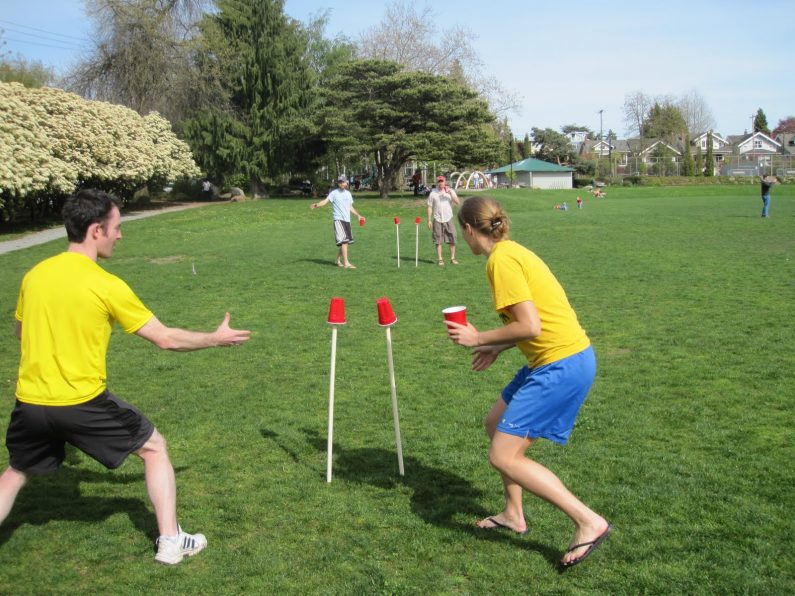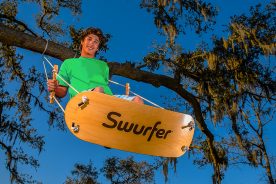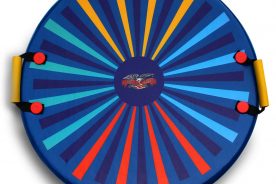School has started, the weather is getting cooler, and it is almost fall. For some people it’s just another season change, but for others it’s the beginning of the best time of the year – football season! Whether it’s a high school game under the lights on a Friday night, a college game at your alma mater on Saturday at mid-day, or a pro game on Sunday from the comfort of your recliner, almost everyone can relate to this season in some capacity.
Along with football season is another time of year all football buffs anticipate, tailgating season. Even the most indifferent football fan can get excited about game day if they know tailgating will be involved. Because who wouldn’t love a morning or afternoon of snacks, drinks, and outdoor games in near perfect weather?
Whether you actually do your tailgating from the tailgate of a truck or just find a grassy field or even set up in your own backyard, there are just some things that are needed to make a tailgate party complete. One of those things is some great yard games. There has always been a long list of yard games to participate in from croquet to bean bags to horseshoes. But there is a much shorter list of games that have become widely recognized among tailgaters across the country. You’ll find some of the most popular tailgating games for game day, or any day, below.
Cornhole
Other Names
Bags, Corn Toss, Bean Bags, Baggo, Bean Bag Toss
Number of People
Bags is typically played with two teams, one on each side of the board. Teams can consist of 1-2 people. When playing with only one person per team, players need to walk back and forth between the boards after completing a round.
Area Needed
Boards should be placed on a relatively level playing surface. The recommended distance for placing the boards on the court is 33 feet between the holes or 27 feet between the bottoms of the boards. When set up to play, the boards are angled with the top of the board 12 inches above the ground and the bottom of the board 3 inches above the ground.
A large grassy area is usually best for this game as grass is more forgiving on the bean bags than concrete or other hard surfaces. The width of the play space can vary but needs enough room for the 2-foot-wide boards and space for a pitcher’s box where players stand to throw the bags.
Materials Needed
Two platforms or boards and two sets of bags.
The boards or platforms are typically made of wood, but can also be made of a heavy plastic or other hard, durable material. Each board is 2 feet wide by 4 feet long. A 6-inch hole is positioned in the center of the board 9 inches from the top.
The two sets of bags each contain 4 bags. The sets come in two separate, identifiable colors to distinguish between teams. Regulation sized bags are 6 inches by 6 inches and weigh between 15-16 ounces. They are typically made of fabric that is double-seamed and filled with dried corn kernels or beans.
Basic Rules
- Matches are broken into innings or frames. During an inning one member from each team pitches from one platform while the other member of each team pitches from the other.
- The first side of players alternates throwing a bag at the opposing board until all four of their bags have been thrown. Players calculate their score based on how many bags were tossed into a hole and how many landed on the board. The next inning continues with the opposing players pitching the bags in alternating order back to the opposing board. The team that scored in the previous inning leads the pitching in the next inning, unless there was no score than the team that pitched last gets to pitch first in the next inning.
- Players must pitch from a three-foot pitcher’s box on either side of the platform. They get 20 seconds to throw a bag. Their foot cannot pass the front of the board or it is considered a foul and no points are scored.
- Scoring is based only on bags that are tossed into the hole or land on the board. A bag in the hole is worth 3 points, a bag on the board is worth 1. While there are variations in scoring within groups of players, most bag players use cancellation scoring which means each team totals their score and the difference of the two scores is awarded to the team with the higher score.
- Cornhole matches are over when the first team reaches 21 points.
*For a complete list of rules and regulations you can visit the American Cornhole Association website at www.playcornhole.org.
Kan Jam
Other Names
KanJam, Kan-Jam, Garbage Can Frisbee
Number of People
Kan Jam is played with two teams. Each team consists of 2 players.
Area Needed
The court for playing Kan Jam should be 12-15 feet wide. The scoring containers should be placed 50 feet apart. The 50 feet is measured from the front of the cans.
Materials Needed
One flying disc and two containers with open tops and slots for scoring.
Kan Jam sets are commercially made and can be bought online or in many sporting goods stores. The goals or “kans” are made of plastic and are simple to set up by rolling and inserting tabs on one end into holes on the other.
Basic Rules
- One person on each team stands at opposing ends of the court, next to the goal.
- At the beginning of a turn one teammate throws the flying disc at the opposite goal. When throwing, players must stay behind the front of their goal. The other teammate acts as a deflector and, when necessary, can deflect or redirect the flying disc towards the goal. The deflector is not allowed to touch the goal. A round ends with the second teammate throwing the flying disc back to the opposing goal. It is then the other team’s turn.
- Points are scored when either the thrower or the deflector gets the flying disc to hit or land inside the goal. One point is scored for “dinger”, which means the deflector directs the disc into the side of the kan. Two points are scored for a Deuce, meaning the thrower hits the side of the kan with not help from the deflector. A “bucket” is three points and occurs when the flying disc is deflected into the top or the front slot of the kan. Teams can score an instant win if the thrower is able to put the disc in the front slot or the top with no help from the deflector.
- Kan Jam is played until one team reaches 21 points.
*For more detailed rules and to order an official Kan Jam set, visit www.kanjam.com.
Ladder Golf
Other Names
Ladder Toss, Ladder Ball
Number of People
Two teams of 1-2 people per team.
Area Needed
Game ladders should be placed 15 feet apart. For smaller yards or while tailgating with limited space, 5 paces is typically sufficient.
Materials Needed
Two sets of 3 bolas. Bolas are two golf balls, spaced 13 inches apart, attached with a piece of nylon rope. Each set should be in a different color.
Two game ladders are also needed. Ladders can be purchased and assembled or you can build them yourself using PVC pipe. Each ladder is built on a base and consists of 3 steps, or rungs. Each rung is spaced 13 inches apart.
Basic Rules
- When playing on a team, teammates stand at a game ladder opposite each other. Game play starts on the same end with opposing teams throwing all 3 of their bolas to the opposite game ladder.
- One player throws all 3 of his bolas then the other player takes his turn. Players throw from 15 feet away from the opposite ladder and can throw however they choose in order to get the bola to catch on one of the rungs. While teams are not allowed to block each other’s bolas they are encouraged to try and knock the other teams’ off of the rungs.
- Points are totaled at the end of a round. Bolas on the top rung are worth 3 points, middle rung is 2 points and bottom rung is 1 point. The first team to 21 is the winner. If a team goes over 21 the points in that round do not count.
*For a more detailed set of rules visit laddergolf.com/pages/official-rules
Washer Toss
Other Names
Washers, Washer Box, Washer Pitchin
Number of People
Washer Toss can be played with 2-4 people, either 2 teams of 1 person each or 2 teams of 2 people each.
Area Needed
The area for play should include room for two 16” x 16” washer pits or boxes that are placed 25 feet apart from the center of the cups.
Materials Needed
Two washer pits or boxes that measure 16 inches wide x 16 inches long x 4 inches tall. Each box has a cup that is 4 ½ inches in diameter and 5 inches high. Eight large washers that are approximately 2 inches in diameter. There should be two sets of 4 washers in distinguishable colors for opposing teams.
Basic Rules
- Play begins with one person from each team pitching a washer toward the opposite box. Whichever team’s washer is closest to the hole will begin the game. This is often referred to as the “diddle”.
- Teammates position themselves next to opposite washer boxes, sharing a box with their opponent. The team that won the “diddle” begins by pitching all 4 of their washers to the opposite box. The opposing team then takes a turn pitching all of their washers. Play then alternates to the opposite side with the team that scored in the previous round earning the right to pitch first.
- Points are totaled at the end of each round. One point is given for any washers that land inside the box, 3 points for any that land inside the cup. Teams cancel out each other’s scores so that only the team with the most points per round is awarded those points. For example if Team 1 lands two washers in the hole and Team lands one washer in the hole, Team 1 scores 3 points.
- Play continues until one team scores exactly 21 points.
Flimsee Frisbee
Other Names
Flimsee Cups, Frisbee Cup Game
Number of People
Flimsee Frisbee can be played 1 on 1 or with 2 teams of 2.
Area Needed
The court or area of play is 16 inches wide and 35 feet long. Players will need some extra width on either side of the poles to stand and have room to throw.
Flimsee Frisbee is almost always played in a grassy area as the required poles need to be stuck into the ground. Some commercially produced sets come with stands for indoor play or for playing in a parking lot during tailgating.
Materials Needed
Four rods or sticks measuring approximately 55” tall. The sticks should be “flimsy” and lightweight so that they flex and bend easily. Plastic pipe or thin wooden dowels work well when making your own.
Play also requires 4 plastic cups such as red plastic drink cups. You will also need two 10” Frisbees or discs that weigh approximately 120 grams. Frisbees or discs can be purchased at most sporting goods stores. If you’re interested in playing more “official” Flimsee Frisbee there are several companies and websites that sell pre-made games with all of the equipment you’ll need included.
Basic Rules
- Rods are placed in the ground 16 inches apart to create a goal and at a distance of 35 feet from the other pair. Plastic cups are turned upside down on top of the rods.
- Each team stands at opposite ends of the Flimsee Frisbee field next to the sticks. The team with the shortest player goes first and each person on the team throws one disc toward their opponent’s goal.
- Teams can score points by floating the disc through their opponent’s goal or by knocking their cups to the ground. Two points are scored for a “clean through” and 1 point is given for knocking down a cup. A clean through must float between the poles without touching anything and be below the cups and above the grass.
- The opposing team can defend their goal by catching a cup mid-air and not allowing it to touch the ground, thus preventing the throwing team from scoring a point. Teams cannot block a Frisbee from going through the goal.
- Once a team reaches 6 points the switch sides to keep game play even. The first team to 12 points is the winner.
*For a more detailed set of rules visit www.flimsee.com/pages/how-to-play
While most people associate tailgating with rows of cars parked on a college campus starting early on a Saturday morning, this widely attended activity doesn’t have to require tickets or a drive to the game. In fact, it doesn’t even have to involve a tailgate. As long as you are surrounded by a few close friends, some of your favorite foods, and a couple of fun tailgating games, you can have a tailgate party in your own garage or backyard.
Simply grab the materials you need to create one of these games for yourself or visit one of the many websites and stores that manufacture and box these games with everything you need to play. Most also include a convenient carrying case so they can easily be carried to your next tailgate or backyard party.















No Comments